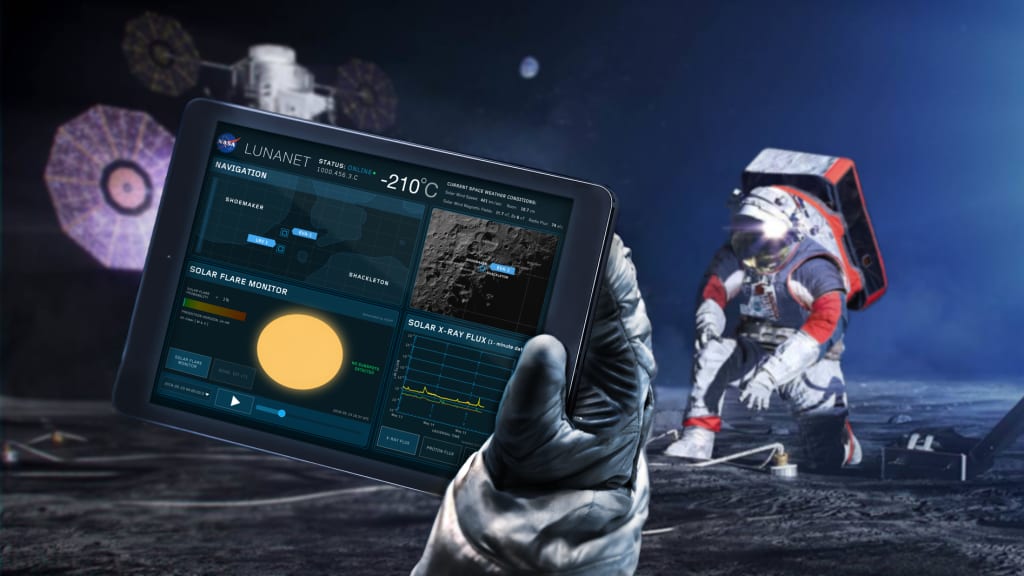Lunar Communication and Navigation
Connecting and Guiding Explorers Beyond Earth.

As we embark on lunar missions, establishing reliable communication and navigation systems becomes crucial for the success of robotic and human exploration on the moon. The challenges of operating in the lunar environment necessitate advanced technologies for data transmission, establishing communication networks, and precise navigation. In this article, we will delve into the technologies and systems used for lunar communication and navigation, highlighting their importance for successful lunar missions.
Communication between Earth and the moon is a vital lifeline for lunar missions. Data transmission must overcome the vast distances and potential signal delays involved. To achieve this, space agencies and organizations employ various methods, including deep space communication networks and relay satellites. Deep space communication networks, such as NASA's Deep Space Network, consist of ground-based antennas strategically located around the world. These antennas receive and transmit signals to spacecraft, ensuring constant communication coverage. Relay satellites in lunar orbit can also act as intermediaries, receiving signals from lunar landers or rovers and relaying them to Earth, enhancing communication efficiency.
For data transmission, radio waves are commonly used due to their ability to penetrate the lunar atmosphere. High-frequency radio waves can carry large amounts of data over long distances, enabling real-time communication and data transfer between the moon and Earth. However, the lunar environment presents challenges, such as signal degradation caused by lunar terrain or interference from solar radiation. Mitigation strategies, such as antenna design optimization and error correction techniques, are employed to ensure reliable data transmission in the lunar environment.
In addition to Earth-based communication, establishing local communication networks on the moon is essential for efficient operations. Robotic missions and future lunar settlements require reliable communication within the lunar environment. This is achieved through the deployment of communication infrastructure, including lunar orbiters, landers, and rovers equipped with communication equipment. These systems enable direct communication between lunar assets, enhancing coordination and data sharing among robotic explorers.
Furthermore, precise navigation is crucial for safe and accurate lunar missions. Navigating in the lunar environment presents unique challenges due to the absence of a global positioning system (GPS) and the need to account for the moon's uneven surface. To overcome these challenges, spacecraft and rovers rely on a combination of navigation methods, including inertial measurement units (IMUs), star trackers, and terrain mapping.
IMUs utilize gyroscopes and accelerometers to measure the spacecraft's orientation and movement, providing real-time data for navigation. Star trackers are optical devices that identify and track stars to determine the spacecraft's attitude relative to celestial reference points. These celestial navigation techniques enable precise orientation and heading determination in space. Lunar landers and rovers also utilize terrain mapping and vision-based systems to navigate the lunar surface. By analyzing the topography and landmarks, they can autonomously plan routes and avoid obstacles.
In recent years, advancements in autonomous navigation have been made, enabling robotic explorers to make more informed decisions in real-time. Machine learning algorithms, computer vision, and sensor fusion techniques are utilized to enhance navigation capabilities, allowing rovers to navigate more efficiently and adapt to the dynamic lunar terrain.
Reliable communication and navigation are equally crucial for human exploration on the moon. Astronauts require continuous communication with mission control on Earth to relay information, receive instructions, and maintain a connection to their home planet. Communication delays, known as latency, can impact real-time decision-making and emergency response. Therefore, establishing robust communication networks that minimize latency is essential for the safety and success of human missions.
Accurate navigation is paramount for crewed missions, as astronauts need to precisely locate themselves and their vehicles on the lunar surface. This is crucial for extravehicular activities (EVAs) and traversing the challenging lunar landscape. Advanced navigation systems, combined with real-time mapping and situational awareness tools, ensure the astronauts can navigate safely and efficiently.
In conclusion, reliable communication and precise navigation are indispensable components of successful lunar missions. The technologies and systems employed for lunar communication, including deep space communication networks and relay satellites, ensure seamless data transmission between Earth and the moon. Local communication networks and infrastructure on the moon enable efficient coordination among robotic assets. Precise navigation methods, utilizing IMUs, star trackers, and autonomous navigation techniques, allow for safe and accurate exploration of the lunar environment. For future human missions, robust communication and navigation systems are essential for astronaut safety and mission success. As we venture further into the depths of space, these critical systems will continue to evolve and play a pivotal role in our ongoing exploration of the moon and beyond.
About the Creator
Enjoyed the story? Support the Creator.
Subscribe for free to receive all their stories in your feed. You could also pledge your support or give them a one-off tip, letting them know you appreciate their work.





Comments
There are no comments for this story
Be the first to respond and start the conversation.